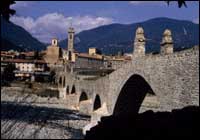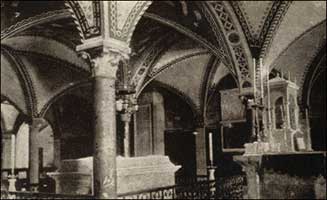Brief Biography of Saint Columban or Columbanus.St. Columban of Bobbio (542 -615)
Saint Columban—the dove of Christ— brought true Christianity back to Europe and especially northern Italy after the fall of the Roman Empire. The name means dove or little dove in Latin. He popularized that name throughout the Continent. That was the name that Giovanni Griego chose when he arrived in Spain and changed his name to Christopher Columbus. Columbus was no dove however....!! "Columbanus was, in many respects, the greatest, bravest, most thoroughly national, and most representative of all the warriors of the cross sent forth from Irish shores. Born in Leinster, A.D. 543, he was educated first of all on one of the islands of Lough Erne. Thence he migrated to Bangor, which was then at the height of its fame as a place where the greatest attainments in learning and sanctity were possible. We are apt to undervalue the studies of these ancient monasteries, just as we, in our intellectual conceit, are apt to undervalue all mediaeval learning, because the men of those times knew nothing of the daily press, photography, electricity, or gunpowder. In monasteries like Bangor, the range of studies was a wide one, and it must have been a thoroughly equipped and vigorous seat of learning in the latter half of the sixth century, when it could have despatched such a trained and even elegant scholar as Columbanus to convert the pagans of France. The proofs of his learning are evident to any student of his writings. The scholarship of them is manifest. He wrote good Latin verses, full of quaint, metrical conceits, both in the classical and monkish rhyming style. Allusions to pagan and Christian antiquity abound In his poems. Where did he acquire this scholarship? His life on the Continent was one of rough, vigorous, all-absorbing, practical effort, leaving no time for such studies. Even did time or leisure permit, the opportunity was wanting, for the Continent, was at that time plunged in utter darkness, literary as well as spiritual. St. Columbanus, we therefore conclude, gained his extensive knowledge and eloquent scholarship at the abbeys of Bangor and Lough Erne. "France was, toward the end of the sixth century, a bye-word throughout Europe for immorality and irreligion. When we think of the Gaul of that period, we must not think of it as it was in the fourth and fifth centuries, the age of Hilary of Poitiers, of a Martin of Tours, or a Germanus of Auxerre. For a hundred years back, it had been the prey of every invader. Milman, in his " Latin Christianity," says: " It is difficult to conceive a more dark and, odious state of society then that of France under her Merovingian kings, the descendants of Clovis, as described by Gregory of Tours. In the conflict of coalition of barbarism with Roman Christianity, barbarism has introduced into Christianity all its ferocity, with none of its generosity or magnanimity. Its energy shows itself in atrocity of cruelty, and even of sensuality. Throughout, assassinations, parricides, and fratricides intermingle with adulteries and rapes. That King Clotaire should burn alive his rebellious son with his wife and daughter is fearful enough, but we are astounded at the fact of a bishop of Tours, even in these times, having burned a man alive, to obtain the deeds of an estate which he coveted. Fredegonde, wife of Chilperic I., one of the grandsons of Clovis, sends two murderers to assassinate Childebert, and these assassins are clergymen. She causes the Archbishop of Rouen to be murdered while chanting the service in church ; and in this crime a bishop and an archdeacon are her accomplices. Marriage was a bond contracted and broken on the slightest occasion. "It was into a country where all the bonds which bind society together were totally dissolved, that St. Columbanus flung himself with all the headlong courage of his race, to be the champion of morals, the apostle of "civilization, the fearless soldier of the cross of Christ. The two languages used by him, the Celtic and the Latin, would, of course, carry him everywhere ; and the king eventually settled upon him the old Roman castle of Annegray, where the first Irish monastery ever planted on the Continent raised its head. There he laid the foundations of his system as he had learned it in Ireland. These foundations are plain, aye, the very plainest living, high thinking, and hard work. He lived for weeks, according to his biographer, Jonas of Bobio, without any other food than the herbs of the field and the wild fruits yielded by the forest around. We trace in him the same love of nature and of natural objects which we find in some of the beautiful stories told of St. Columba. All nature seems to have obeyed his voice. The birds came to receive his caresses. The squirrels ran to him from the tree-tops to hide themselves in the folds of his cowl. One day, when wandering in the depths of the woods, meditating whether the ferocity of brutes, which could not sin, was not better than the rage of men, which destroyed their souls, he saw a dozen wolves approach and surround him on all sides. He remained motionless, repeating the words, Deus in adjutorium. The wolves touched his garment with their mouths, but seeing him fearless, passed upon their way. "The example of a quiet Christian household, shedding the blessings of civilization, education, and religion all around, proved a very powerful one, even upon men more ferocious than wolves. Crowds flocked to the Irish teacher to learn the secret of a pure and happy life, and the great foundations of Luxeuil and Fontaines followed one another in rapid succession. Among the disciples of Columbanus were numbered by hundreds the children of the noblest Franks and Burgundians. For twenty years this great missionary thus labored, till the crisis of his life came, and his activity was changed to a new direction. Having been driven from France owing to his quarrel with the wicked Queen Brunhilde, his only chance of escape was by the Rhine to Switzerland, whence, after successful labors, he painfully crossed the Alps into Italy, where he was received with great respect and endowed with the church and territory of Bobio. Columbanus; undertook to restore the old church of St. Peter's, which was in existence there, and to add to it a monastery. Despite his age, he shared the workmen's labors, and bent his old shoulders under the weight of enormous beams of fir-wood. This Abbey of Bobio was, in one sense, his last stage. He made it a citadel of orthodoxy against the Arians, lighting there a lamp of knowledge and instruction which long illumined Northern Italy. The monastery existed until suppressed by the French in 1803, while the church still serves as a parish church. But Columbanus ended life by seeking a solitude more profound still. Upon the opposite shore of Trebbia he discovered a cavern, which he transformed into a chapel, and there, like other Irish anchorites, he spent his last days " in solitude," till God called His faithful and fearless servant home, on November 21, 615." Excerpted from The Irish Element in Medieval Culture by H. Zimmer, trans. from the German and published by G.P. Putnam's Sons, New York, 1891. Saint Columban of Bobbio from the History of the Scottish Nation. The Great Passover Controversy from the History of the Scottish Nation. |

